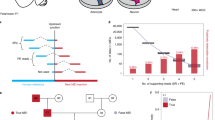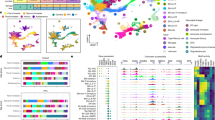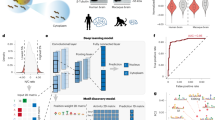Abstract
Neural progenitor cells undergo somatic retrotransposition events, mainly involving L1 elements, which can be potentially deleterious. Here, we analyze the whole genomes of 20 brain samples and 80 non-brain samples, and characterized the retrotransposition landscape of patients affected by a variety of neurodevelopmental disorders including Rett syndrome, tuberous sclerosis, ataxia-telangiectasia and autism. We report that the number of retrotranspositions in brain tissues is higher than that observed in non-brain samples and even higher in pathologic vs normal brains. The majority of somatic brain retrotransposons integrate into pre-existing repetitive elements, preferentially A/T rich L1 sequences, resulting in nested insertions. Our findings document the fingerprints of encoded endonuclease independent mechanisms in the majority of L1 brain insertion events. The insertions are “non-classical” in that they are truncated at both ends, integrate in the same orientation as the host element, and their target sequences are enriched with a CCATT motif in contrast to the classical endonuclease motif of most other retrotranspositions. We show that L1Hs elements integrate preferentially into genes associated with neural functions and diseases. We propose that pre-existing retrotransposons act as “lightning rods” for novel insertions, which may give fine modulation of gene expression while safeguarding from deleterious events. Overwhelmingly uncontrolled retrotransposition may breach this safeguard mechanism and increase the risk of harmful mutagenesis in neurodevelopmental disorders.
Similar content being viewed by others
Log in or create a free account to read this content
Gain free access to this article, as well as selected content from this journal and more on nature.com
or
References
Burns KHH, Boeke JDD . Human transposon tectonics. Cell 2012; 149:740–752.
Lander ES, Linton LM, Birren B, et al. Initial sequencing and analysis of the human genome. Nature 2001; 409:860–921.
Ewing AD, Kazazian Jr HH, Kazazian HH . High-throughput sequencing reveals extensive variation in human-specific L1 content in individual human genomes. Genome Res 2010; 20:1262–1270.
Hancks DC, Kazazian HH . Active human retrotransposons: variation and disease. Curr Opin Genet Dev 2012; 22:191–203.
Levin HL, Moran JV . Dynamic interactions between transposable elements and their hosts. Nat Rev Genet 2011; 12:615–627.
Brouha B, Schustak J, Badge RM, et al. Hot L1s account for the bulk of retrotransposition in the human population. Proc Natl Acad Sci USA 2003; 100:5280–5285.
Konkel MK, Walker JA, Hotard AB, et al. Sequence analysis and characterization of active human alu subfamilies based on the 1000 Genomes Pilot Project. Genome Biol Evol 2015; 7:2608–2622.
Rechavi G, Givol D, Canaani E . Activation of a cellular oncogene by DNA rearrangement: possible involvement of an IS-like element. Nature 1982; 300:607–611.
Amariglio EN, Hakim I, Brok-Simoni F, et al. Identity of rearranged LINE/c-MYC junction sequences specific for the canine transmissible venereal tumor. Proc Natl Acad Sci USA 1991; 88:8136–8139.
Miki Y, Nishisho I, Horii A, et al. Disruption of the APC gene by a retrotransposal insertion of L1 sequence in a colon cancer. Cancer Res 1992; 52:643–645.
Lee E, Iskow R, Yang L, et al. Landscape of somatic retrotransposition in human cancers. Science 2012; 337:967–971.
Helman E, Lawrence MLS, Stewart C, Sougnez C, Getz G, Meyerson M . Somatic retrotransposition in human cancer revealed by whole-genome and exome sequencing. Genome Res 2014; 24:1053–1063.
Erwin JA, Paquola ACM, Singer T, et al. L1-associated genomic regions are deleted in somatic cells of the healthy human brain. Nat Neurosci 2016; 19:1583–1591.
Baillie JK, Barnett MW, Upton KR, et al. Somatic retrotransposition alters the genetic landscape of the human brain. Nature 2011; 479:534–537.
Coufal NG, Garcia-Perez JL, Peng GE, et al. L1 retrotransposition in human neural progenitor cells. Nature 2009; 460:1127–1131.
Muotri AR, Chu VT, Marchetto MCN, Deng W, Moran JV, Gage FH . Somatic mosaicism in neuronal precursor cells mediated by L1 retrotransposition. Nature 2005; 435:903–910.
Upton KR, Gerhardt DJ, Jesuadian JS, et al. Ubiquitous L1 mosaicism in hippocampal neurons. Cell 2015; 161:228–239.
Evrony GD, Cai X, Lee E, et al. Single-neuron sequencing analysis of L1 retrotransposition and somatic mutation in the human brain. Cell 2012; 151:483–496.
Muotri AR, Marchetto MCN, Coufal NG, et al. L1 retrotransposition in neurons is modulated by MeCP2. Nature 2010; 468:443–446.
Coufal NG, Garcia-Perez JL, Peng GE, et al. Ataxia telangiectasia mutated (ATM) modulates long interspersed element-1 (L1) retrotransposition in human neural stem cells. Proc Natl Acad Sci USA 2011; 108:20382–20387.
Amir RE, Van den Veyver IB, Wan M, Tran CQ, Francke U, Zoghbi HY . Rett syndrome is caused by mutations in X-linked MECP2, encoding methyl-CpG-binding protein 2. Nat Genet 1999; 23:185–188.
Savitsky K, Sfez S, Tagle DA, et al. The complete sequence of the coding region of the ATM gene reveals similarity to cell cycle regulators in different species. Hum Mol Genet 1995; 4:2025–2032.
Crino PB, Nathanson KL, Henske EP . The Tuberous Sclerosis Complex. N Engl J Med 2006; 355:1345–1356.
Ess KC, Kamp CA, Tu BP, Gutmann DH . Developmental origin of subependymal giant cell astrocytoma in tuberous sclerosis complex. Neurology 2005; 64:1446–1449.
Zhou J, Shrikhande G, Xu J, et al. Tsc1 mutant neural stem/progenitor cells exhibit migration deficits and give rise to subependymal lesions in the lateral ventricle. Genes Dev 2011; 25:1595–1600.
Lai MC, Lombardo MV, Baron-Cohen S . Autism. Lancet 2014; 383:896–910.
Erwin JA, Marchetto MC, Gage FH . Mobile DNA elements in the generation of diversity and complexity in the brain. Nat Rev Neurosci 2014; 15:497–506.
Stewart C, Kural D, Strömberg MP, et al. A comprehensive map of mobile element insertion polymorphisms in humans. PLoS Genet 2011; 7:e1002236.
Coffee B, Cox HC, Kidd J, et al. Detection of somatic variants in peripheral blood lymphocytes using a next generation sequencing multigene pan cancer panel. Cancer Genet 2017; 211:5–8.
Ross MT, Grafham D V, Coffey AJ, et al. The DNA sequence of the human X chromosome. Nature 2005; 434:325–337.
Rogers JH . The origin and evolution of retroposons. Int Rev Cytol 1985; 93:187–279.
Myers JS, Vincent BJ, Udall H, et al. A comprehensive analysis of recently integrated human Ta L1 elements. Am J Hum Genet 2002; 71:312–326.
Levy A, Schwartz S, Ast G . Large-scale discovery of insertion hotspots and preferential integration sites of human transposed elements. Nucleic Acids Res 2009; 38:1515–1530.
Giordano J, Ge Y, Gelfand Y, Abrusán G, Benson G, Warburton PE . Evolutionary history of mammalian transposons determined by genome-wide defragmentation. PLoS Comput Biol 2007; 3:e137.
Graham T, Boissinot S . The genomic distribution of L1 elements: the role of insertion bias and natural selection. J Biomed Biotechnol 2006; 2006:1–5.
Morrish TA, Gilbert N, Myers JS, et al. DNA repair mediated by endonuclease-independent LINE-1 retrotransposition. Nat Genet 2002; 31:159–165.
Sen SK, Huang CT, Han K . Batzer Ma . Endonuclease-independent insertion provides an alternative pathway for L1 retrotransposition in the human genome. Nucleic Acids Res 2007; 35:3741–3751.
Jurka J . Sequence patterns indicate an enzymatic involvement in integration of mammalian retroposons. Proc Natl Acad Sci USA 1997; 94:1872–1877.
Richardson SR, Doucet AJ, Kopera HC, Moldovan JB, Garcia-Perez JL, Moran JV . The influence of LINE-1 and SINE retrotransposons on mammalian genomes. Microbiol Spectrum 2015; 3:1–40.
Yant SR, Zhu W, Millinoff D, Slightom JL, Goodman M, Gumucio DL . High affinity YY1 binding motifs: Identification of two core types (ACAT and CCAT) and distribution of potential binding sites within the human beta globin cluster. Nucleic Acids Res 1995; 23:4353–4362.
Tesfazghi M, Riman S . Alexander Karen, Rizkallah R, Hurt M . The recruitment of the transcription factor yy1 to dna damage sites in human cells. FASEB J 2015; 29:LB186.
Becker KG, Swergold GD, Ozato K, Thayer RE . Binding of the ubiquitous nuclear transcription factor YY1 to a cis regulatory sequence in the human LINE-1 transposable element. Hum Mol Genet 1993; 2:1697–1702.
Han JS, Szak ST, Boeke JD . Transcriptional disruption by the L1 retrotransposon and implications for mammalian transcriptomes. Nature 2004; 429:268–274.
Bacchelli E, Ceroni F, Pinto D, et al. A CTNNA3 compound heterozygous deletion implicates a role for α T-catenin in susceptibility to autism spectrum disorder. J Neurodev Disord 2014; 6:17.
Lionel AC, Vaags AK, Sato D, et al. Rare exonic deletions implicate the synaptic organizer Gephyrin (GPHN) in risk for autism, schizophrenia and seizures. Hum Mol Genet 2013; 22:2055–2066.
Piton A, Michaud JL, Peng H, et al. Mutations in the calcium-related gene IL1RAPL1 are associated with autism. Hum Mol Genet 2008; 17:3965–3974.
Schmunk G, Gargus JJ . Channelopathy pathogenesis in autism spectrum disorders. Front Genet 2013; 4:222.
Ben-Shalom R, Keeshen CM, Berrios KN, An JY, Sanders SJ, Bender KJ . Opposing effects on NaV1.2 function underlie differences between SCN2A variants observed in individuals with autism spectrum disorder or infantile seizures. Biol Psychiatry 2017; 82:224–232.
Eyre-Walker A, Keightley PD . The distribution of fitness effects of new mutations. Nat Rev Genet 2007; 8:610–618.
Papavasiliou FN, Schatz DG . Somatic hypermutation of immunoglobulin genes. Cell 2002; 109:S35–S44.
Beck CR, Garcia-Perez JL, Badge RM, Moran JV . LINE-1 elements in structural variation and disease. Annu Rev Genomics Hum Genet 2011; 12:187–215.
Thomas CA, Paquola ACMM, Muotri AR . LINE-1 retrotransposition in the nervous system. Annu Rev Cell Dev Biol 2012; 28:555–573.
Simons C, Pheasant M, Makunin IV, Mattick JS . Transposon-free regions in mammalian genomes. Genome Res 2006; 16:164–172.
Humphrey A, Higgins JNP, Yates JRW, Bolton PF . Monozygotic twins with tuberous sclerosis discordant for the severity of developmental deficits. Neurology 2004; 62:795–798.
Miyake K, Yang C, Minakuchi Y, et al. Comparison of genomic and epigenomic expression in monozygotic twins discordant for Rett Syndrome. PLoS One 2013; 8:e66729.
Hu VW, Frank BC, Heine S, Lee NH, Quackenbush J . Gene expression profiling of lymphoblastoid cell lines from monozygotic twins discordant in severity of autism reveals differential regulation of neurologically relevant genes. BMC Genomics 2006; 7:118.
Li W, Jin Y, Prazak L, Hammell M, Dubnau J . Transposable elements in TDP-43-mediated neurodegenerative disorders. PLoS One 2012; 7:1–10.
Bundo M, Toyoshima M, Okada Y, et al. Increased l1 retrotransposition in the neuronal genome in schizophrenia. Neuron 2014; 81:306–313.
Eickbush TH . Repair by retrotransposition. Nat Genet 2002; 31:126–127.
Ono R, Ishii M, Fujihara Y, et al. Double strand break repair by capture of retrotransposon sequences and reverse-transcribed spliced mRNA sequences in mouse zygotes. Sci Rep 2015; 5:12281.
Doucet-O'Hare TT, Rodić N, Sharma R, Darbari I, Abril G, Choi JA, et al. LINE-1 expression and retrotransposition in Barrett's esophagus and esophageal carcinoma. Proc Natl Acad Sci USA 2015; 112:E4894–E4900.
Suberbielle E, Sanchez PE, Kravitz A V, et al. Physiologic brain activity causes DNA double-strand breaks in neurons, with exacerbation by amyloid-β. Nat Neurosci 2013; 16:613–621.
Adamec E, Vonsattel JP, Nixon RA . DNA strand breaks in Alzheimer's disease. Brain Res 1999; 849:67–77.
Gao Y, Sun Y, Frank KM, et al. A critical role for DNA end-joining proteins in both lymphogenesis and neurogenesis. Cell 1998; 95:891–902.
Wei PC, Chang AN, Kao J, et al. Long neural genes harbor recurrent dna break clusters in neural stem/progenitor cells. Cell 2016; 164:644–655.
Drmanac R, Sparks AB, Callow MJ, et al. Human genome sequencing using unchained base reads on self-assembling DNA nanoarrays. Science 2010; 327:78–81.
Carnevali P, Baccash J, Halpern AL, et al. Computational techniques for human genome resequencing using mated gapped reads. J Comput Biol 2012; 19:279–92.
Quinlan AR, Hall IM . BEDTools: a flexible suite of utilities for comparing genomic features. Bioinformatics 2010; 26:841–842.
Langmead B . Aligning short sequencing reads with Bowtie. Curr Protoc Bioinformatics 2010; Chapter 11:Unit 11.7.
Li H, Durbin R . Fast and accurate short read alignment with Burrows-Wheeler transform. Bioinformatics 2009; 25:1754–1760.
Huang X, Miller W . A time-efficient, linear-space local similarity algorithm. Adv Appl Math 1991; 12:337–357.
Carmi S, Hui KY, Kochav E, et al. Sequencing an Ashkenazi reference panel supports population-targeted personal genomics and illuminates Jewish and European origins. Nat Commun 2014; 5:4835.
C Yuen RK, Merico D, Bookman M, et al. Whole genome sequencing resource identifies 18 new candidate genes for autism spectrum disorder. Nat Neurosci 2017; 20:602–611.
Acknowledgements
We thank the Kahn Family Foundation for their continuous support. This work was supported in part by grants from the Flight Attendant Medical Research Institute (FAMRI), and by the I-CORE Program of the Planning and Budgeting Committee and the Israel Science Foundation (Grant numbers 41/11 and 1796/12). GR is a member of the Sagol Neuroscience Network and holds the Djerassi Chair in Oncology at the Sackler Faculty of Medicine, Tel Aviv University. Human brain tissues were obtained from the NICHD Brain and Tissue Bank for Developmental Disorders at the University of Maryland, Baltimore, MD. This work was performed in partial fulfilment of the requirements for a PhD degree to JJ-H and BK, The Mina and Everard Goodman Faculty of Life Sciences, Bar Ilan University.
Author information
Authors and Affiliations
Corresponding author
Additional information
( Supplementary information is linked to the online version of the paper on the Cell Research website.)
Supplementary information
Supplementary information, Figure S1
Detection and Characterization of MEI Events. (PDF 234 kb)
Supplementary information, Figure S2
Overall study workflow. (PDF 207 kb)
Supplementary information, Figure S3
Verification and characterization of L1Hs insertion events using PCR and Sanger sequencing. (PDF 401 kb)
Supplementary information, Figure S4
Verification of L1Hs insertions that were detected by CG sequencing using the Pacific Biosciences technology. (PDF 276 kb)
Supplementary information, Figure S5
Somatic L1Hs and AluY event identification. (PDF 179 kb)
Supplementary information, Figure S6
Chromosomal distribution of somatic L1Hs insertions. (PDF 107 kb)
Supplementary information, Figure S7
L1Hs events validated by 3′ Illumina targeted sequencing. (PDF 68 kb)
Supplementary information, Figure S8
Preferred insertion of L1Hs into the most homologous and not the most prevalent L1 family host sequence. (PDF 128 kb)
Supplementary information, Figure S9
Stringent analysis of L1Hs insertion truncation in brain samples. (PDF 112 kb)
Supplementary information, Figure S10
L1Hs insertion length in the AT samples compared to the NB samples. (PDF 88 kb)
Supplementary information, Figure S11
Insertion of somatic L1Hs in long non-coding RNA. (PDF 82 kb)
Supplementary information, Figure S12
Enriched functional groups of genes with non-nested L1Hs insertions. (PDF 110 kb)
Supplementary information Tables
Supplementary information, Table S1a–S1b (PDF 212 kb)
Supplementary information, Table S2
Verification and characterization of L1Hs insertion events. (PDF 58 kb)
Supplementary information, Tables
Supplementary information, Table S3a–S3b (PDF 244 kb)
Supplementary information, Table S4
Examples of nested L1Hs insertions that are truncated at the 3′ end, that were detected by whole genome sequencing by Pacific Biosciences. (PDF 63 kb)
Supplementary information, Table S5
Selected neural genes with somatic L1Hs insertions. (PDF 321 kb)
Supplementary information, Datas S1
Supplementary information, Datas S1–S5 (PDF 351 kb)
Rights and permissions
About this article
Cite this article
Jacob-Hirsch, J., Eyal, E., Knisbacher, B. et al. Whole-genome sequencing reveals principles of brain retrotransposition in neurodevelopmental disorders. Cell Res 28, 187–203 (2018). https://doi.org/10.1038/cr.2018.8
Received:
Revised:
Accepted:
Published:
Issue date:
DOI: https://doi.org/10.1038/cr.2018.8
Keywords
This article is cited by
-
Retrotransposon: an insight into neurological disorders from perspectives of neurodevelopment and aging
Translational Neurodegeneration (2025)
-
Condensin-mediated restriction of retrotransposable elements facilitates brain development in Drosophila melanogaster
Nature Communications (2024)
-
Investigation of chimeric transcripts derived from LINE-1 and Alu retrotransposons in cerebellar tissues of individuals with autism spectrum disorder (ASD)
Scientific Reports (2024)
-
Altered expression of Csnk1a1p in Autism Spectrum Disorder in Iranian population: case-control study
Scientific Reports (2024)
-
Developmental dynamics of the single nucleus regulatory landscape of pig hippocampus
Science China Life Sciences (2023)



